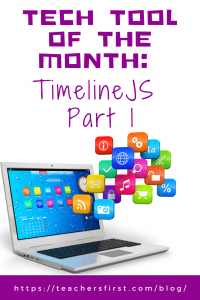Northwestern University’s Knight Lab: TimelineJS is a web tool you can use to create beautiful and interactive timelines. The timelines use text and media links entered into a Google Sheet template provided by the site – it’s even easier than it sounds. You can add a variety of media sources: YouTube, Google Maps, Twitter, and more.
Applying the Triple E Framework
The Triple E Framework, created by Dr. Liz Kolb, is built on the belief that “effective technology integration begins with good instructional strategies and not fancy tools” (tripleeframework.com). Dr. Kolb wrote a book on the topic, Learning First, Technology Second (ISTE, 2017), that lays out the three main uses for technology in education: to Engage, Enhance, or Extend learning goals. Here is a rubric based on the Triple E Framework you can use to evaluate whether TimelineJS (or any other technology) is a good fit for your learning goals and whether you should use it in your lesson.
 Engage in learning goals: TimelineJS motivates students to begin the learning process by allowing them to view the content in an organized and sequential manner. Students are more focused on the task because they are working at their own pace as they view the text, maps, and videos. The extra features also enable students to become more active learners, as they follow the timeline and click through the multimedia elements.
Engage in learning goals: TimelineJS motivates students to begin the learning process by allowing them to view the content in an organized and sequential manner. Students are more focused on the task because they are working at their own pace as they view the text, maps, and videos. The extra features also enable students to become more active learners, as they follow the timeline and click through the multimedia elements. - Enhance learning goals: TimelineJS enhances learning goals by helping students scaffold their learning using a timeline to share sequential information. As students are creating their own timelines, the organization of information helps students deepen their understanding of the content. This tool offers easy collaboration through the use of Google Sheets. Students use higher-order thinking skills to organize their thoughts and tasks in a timeline and creativity to select their choice of videos, maps, text, and other features.
- Extend learning goals: Dr. Kolb describes extended learning as an opportunity for students to learn, connect, and collaborate outside of the regular school day and as a bridge between the school day and real-life experiences. Students can work collaboratively on a timeline by sharing the link to the Google Sheet containing their content. They can also add comments for the team (or their partner) on the Google Sheet. We’re preparing our students for a world that doesn’t exist yet, but most jobs do require independent motivation and knowledge of technology. This tool provides knowledge about both creating timelines and using Google Sheets. Using web tools is a skill that will be helpful for many future classes and career paths.
SAMR Connection
The SAMR Model, by Dr. Ruben Puentedura, suggests that technology implementation has four levels. We can use this model as a guideline to analyze how we’re using technology tools in the classroom. TimelineJS can be used at the levels of Augmentation or Modification – depending on how you’re using the tool.
- Augmentation: At this level, technology acts as a direct substitute for a tool but provides functional improvement. TimelineJS is at the Augmentation level when students are using the timelines they create to learn content, as the videos and maps offer a functional improvement (and interactivity) that cannot happen without technology.
- Modification: At this level, technology allows us to significantly change the tasks associated with an activity, meaning the activity could not be done without technology. TimelineJS allows you to create a product that includes multimedia elements and allows you to collaborate in real-time through Google Sheets, features that are not available without technology.
Don’t miss Part 2 of the Tech Tool of the Month: TimelineJS, where we’ll provide step-by-step instructions for using the tool and introduce ways to use it in the classroom. In the meantime, let us know in the comment section below how you have used TimelineJS in your education setting.


One thought on “Tech Tool of the Month: TimelineJS Part 1”